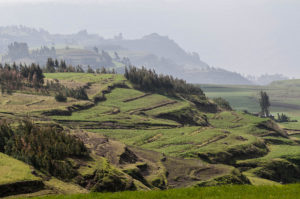
By Barbara Frazer, originally published at CIFOR’s Forests News
As countries gear up for the “Bonn Challenge” of restoring 150 million hectares of deforested and degraded land by 2020, one solution is getting short shrift, scientists say.
Although most plans emphasize turning degraded land into forest plantations, leaving the forest to recover naturally may actually be less costly and more effective for restoring ecosystem functions, says Manuel Guariguata, Team Leader of Forest Management and Restoration at the Center for International Forestry Research (CIFOR).
“Natural regeneration has clear benefits for preserving biodiversity and providing ecosystem services,” Guariguata says. “There was a natural ecosystem in place before the land was converted to agriculture or other uses. So in many cases, letting nature take over unused land again might be the best option.”
Guariguata and other researchers examine the science and policy behind natural forest regeneration and landscape restoration in a recent special issue of the journal Biotropica.
Although natural regeneration is a low-cost way to reduce erosion, protect watersheds and sequester carbon, it is “often overlooked when restoration programs and policies are designed,” according to Maria Uriarte of Columbia University and Robin Chazdon of the University of Connecticut. Uriarte and Chazdon were co-authors of the special issue.
CAUSES OF RESISTANCE
So why ignore something that requires such little human effort?
For one, it can take a regenerating forest three to four decades to reach maturity, and along the way it looks unkempt, Guariguata says. Farmers may not want an area that looks like “abandoned land” on their property and may be tempted to cut it down.
Under the right conditions, however, natural regeneration can make sense for farmers, especially as part of a mosaic landscape that combines agroforestry, crops and natural forest. The key is to determine the biophysical, social and economic conditions that make natural regeneration the most cost-effective option.

That means weighing tradeoffs, including “opportunity cost”—the income a landowner forgoes by dedicating land to one use, such as forest, instead of another, such as agriculture.
“You have to select the piece of land that’s going to have the lowest opportunity cost, because you’re going to leave it unused for some decades,” Guariguata says.
Steep slopes and remote areas that are unattractive for agriculture are good candidates. So are areas where remnants of mature forests remain. Remnant forests serve as sources of seeds that birds and animals scatter in the degraded area between them.
If the remnants are relatively close to each other, regeneration will happen naturally, with time. If they are farther apart, some tree planting might be necessary to jump-start the process. That sort of “active regeneration” also might be necessary in places where land is degraded from intensive use, such as after many years of use as cattle pasture.
Policies that include training for farmers and extension agents in natural regeneration can help ensure success, Uriarte and Chazdon suggest.
Natural regeneration is not a one-size-fits-all solution, however. In some cases, the opportunity cost of leaving land alone for decades may be excessive, and a farmer might opt for agroforestry instead.
Understanding the tradeoffs—which change over time, with changing local circumstances—can help policymakers determine when natural regeneration makes the most economic and ecological sense, according to Guariguata.
But because there has been so little research on natural regeneration, there is a lack of scientific evidence to guide policy decisions. More studies would allow researchers to compare the results of different forest restoration strategies, both for ecosystems and for the people whose livelihoods depends on the forest, Uriarte says.
“There’s not a lot of quantitative, robust data that we can use to model what would happen if we promoted regeneration in one place and not in another,” Chazdon says.
NO ONE-SIZE FITS ALL APPROACH
Restoration can take different forms, including natural regeneration, agroforestry and mixed-species tree plantations, but there is little research on ecological impacts and less about socioeconomic impacts of each.
“Often, restoration is implemented without considering the alternatives. It’s important to ask how people would benefit and how characteristics of the ecosystems would differ if different options were chosen,” says Uriarte.
Decisions about land use also involve tradeoffs—when land is left to allow forest to regenerate naturally, for example, it will no longer be available for agriculture, but it will eventually yield forest products and may provide a buffer against climate change.
“The question is what you get out of a crop versus what you get out of a naturally regenerated forest.”
The answer may vary over time, depending on changing financial conditions, commodity prices or even the weather. “Whatever calculation a person makes about land use is a constantly moving target,” she says, and further study is needed to understand both the tradeoffs and synergies offered by naturally regenerating forests.
Researchers and policymakers also need means for analyzing the costs and benefits of natural regeneration.
“Most of the tools that exist are directed toward initial planning and mapping,” Chazdon says. “There’s a need for more in-depth tools that consider biodiversity data, estimations of carbon benefits of restoration, economic benefits and other factors.”
Regenerating forests often fall into a legal vacuum, ignored by both environmental and agricultural policies. Research could help point to the most effective regulations for encouraging natural regeneration, as well as the best ways to implement those policies and the most effective financial incentives.
“One size does not fit all,” Uriarte says. “Each country has its own history and its own political system, and what works in one place may not work in another.”
“We often hear about proposals to reforest by planting trees,” Guariguata says. “But when you’re talking about millions of trees, that would require a lot of nursery space and a lot of inputs.”
Regeneration—whether completely natural or with some assistance—can help countries meet at least some of their reforestation commitments at a lower cost.
“In many ways,” he says, “Nature knows best.”











